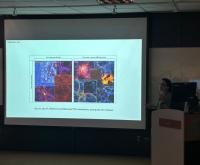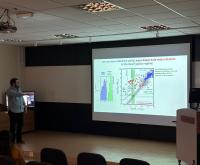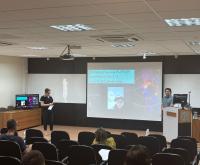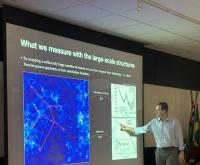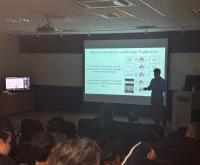SEMINAR OF THE DEPARTMENT OF ASTRONOMY
Multimessenger astrophysics
a talk by Luiz Vitor de Souza Filho (IFSC-USP) - In-Person
Abstract:
Multimessenger astrophysics has emerged as a powerful approach to understanding the universe through the combined detection of different cosmic messengers, including high-energy photons, cosmic rays, neutrinos, and gravitational waves. This new paradigm allows for a deeper exploration of astrophysical phenomena, unveiling the nature of some of the most energetic and mysterious processes in the cosmos. In this talk, I will discuss the role of two major observatories in advancing multimessenger studies: the Cherenkov Telescope Array Observatory (CTAO) and the Pierre Auger Observatory.
The CTAO, a next-generation observatory, will be the most sensitive facility for detecting very-high-energy gamma rays. With its unprecedented sensitivity and large field of view, CTAO is expected to play a crucial role in identifying the sources of high-energy gamma rays and exploring their connection to other cosmic messengers, such as neutrinos and cosmic rays. It will provide insights into extreme astrophysical environments, like supernova remnants, active galactic nuclei, and starburst regions.
The Pierre Auger Observatory, located in Argentina, is the world's largest cosmic ray detector, dedicated to studying the highest-energy particles that reach Earth. Auger's ability to detect ultra-high-energy cosmic rays (UHECRs) has enabled significant advances in understanding their origins, propagation, and interaction with cosmic backgrounds. The recent upgrades to the Auger Observatory have enhanced its capacity to identify the nature of primary particles, contributing to a more precise determination of their sources.
In this presentation, I will explore how the synergy between CTAO and Auger, alongside other multimessenger observatories, enhances our understanding of cosmic accelerators and the astrophysical processes at play. By combining gamma-ray observations from CTAO with the ultra-high-energy cosmic ray data from Auger, we can better constrain source models, probe particle acceleration mechanisms, and address fundamental questions about the nature of the high-energy universe. One example to be explored is the search for Lorentz Invariance Violation. This collaborative approach exemplifies the power of multimessenger astrophysics to push the boundaries of our knowledge and reveal the hidden dynamics of the most extreme events in the universe.
Short-Bio:
Bacharel (1997), mestre (2000) e doutor (2004) em Física pela Universidade Estadual de Campinas. Atuou como pós-doc no Instituto de Astronomia, Geofísica e Ciências Atmosféricas da Universidade de São Paulo até 2007 e como pesquisador na Universidade de Karlsruhe, Alemanha até 2008. Desde agosto de 2008 é Professor da Universidade de São Paulo no Instituto de Física de São Carlos. Trabalha na área de astrofísica de partículas, atuando principalmente nos seguintes temas: análise de dados, instrumentação, simulação de chuveiros atmosféricos e modelagem astrofísica. É membro dos experimentos Pierre Auger e CTA. Atualmente é o presidente do Conselho Superior do Consórcio Cherenkov Telescope Array, Membro do Conselho Administrativo do GMT Observatório, representante da FAPESP nos Conselhos do experimentos do CERN, Gestor de Infraestrutura da FAPESP, Vice-Chefe do Departamento de Física e Ciência Interdisciplinar do IFSC, Presidente da Comissão de Pesquisa e Inovação do IFSC, Membro do Conselho Técnico e Científico da Rede Nacional de Física de Altas Energias e Membro Suplente do Conselho Diretor do Centro Latino Americano de Física (CLAF).
Google Meet: https://meet.google.com/pcw-gmem-jyi
Link da transmissão: https://www.youtube.com/c/AstronomiaIAGUSP/live




